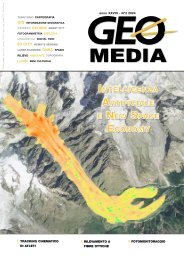Create successful ePaper yourself
Turn your PDF publications into a flip-book with our unique Google optimized e-Paper software.
GUEST<br />
Discovering an Impact<br />
Crater after a Seismic Event<br />
by F. Bernardini, FBIS<br />
Looking for meteor impacts on<br />
Mars surface has been for years<br />
a major research activity performed<br />
by the Context Camera,<br />
CTX, instrument on-board Mars<br />
Reconnaissance Orbiter, MRO.<br />
Their detections provide important<br />
information on sub-surface<br />
structures, in cooperation also<br />
with other instruments.<br />
The detection of these impacts<br />
led recently also to a new important<br />
discovery, a real first in the<br />
field of planetary sciences. We<br />
interviewed dr. Liliya Posiolova<br />
(Sr. Staff Scientist at Malin Space<br />
Science Systems, Inc.) about this<br />
achievement that involved Mars<br />
Reconnaissance Orbiter, its lower<br />
resolution cameras (CTX and<br />
MARCI), and the InSight lander<br />
with its seismometer.<br />
Liliya Posiolova, a senior scientist at Malin Space<br />
Science Systems, looks at photos of a huge crater<br />
that a meteoroid created on Mars last December.<br />
Credits: Adriana Heldiz / The San Diego<br />
Union-Tribune<br />
Q. How did you discovered the<br />
crater and then associated it to<br />
the seismic event recorded by<br />
InSight?<br />
A. The Amazonis Planitia<br />
impact was discovered by our<br />
MRO-CTX/MARCI science<br />
group on February 14, <strong>2022</strong> in<br />
a CTX image taken on February<br />
11, <strong>2022</strong>. The new crater and<br />
surrounding blast zone were a<br />
complete surprise to us because<br />
we had never come across a fresh<br />
crater or blast zone that big. We<br />
knew the impact had occurred<br />
sometime between June 2019<br />
and February <strong>2022</strong>.<br />
The dust disturbance area was so<br />
large that we thought it might<br />
be visible in our lower resolution<br />
camera. We then started<br />
combing through MARCI data<br />
(our weather camera) to see if<br />
we could further constrain the<br />
timing. At first we constrained it<br />
to about 5 days in late December,<br />
but with further processing<br />
we managed to constrain it to<br />
a 25 hour time period centred<br />
roughly on December 24, 2021.<br />
It was that date which triggered<br />
my memory about a large<br />
marsquake reported by InSight’s<br />
MQS (Mars Quake Service) on<br />
Christmas Eve of last year. We<br />
quickly looked up the epicentre<br />
location estimate in the marsquake<br />
catalog and realized that<br />
our crater-to-lander distance<br />
matched almost perfectly the<br />
MQS event-to-lander distance.<br />
So, we had a match - that large<br />
seismic event was caused by this<br />
large crater! The largest crater<br />
we have found in 16 years of<br />
MRO mission! I was thrilled by<br />
this discovery when I realized<br />
that I was, in fact, looking at the<br />
source of a global seismic event.<br />
26 <strong>GEOmedia</strong> n°6-<strong>2022</strong>


















